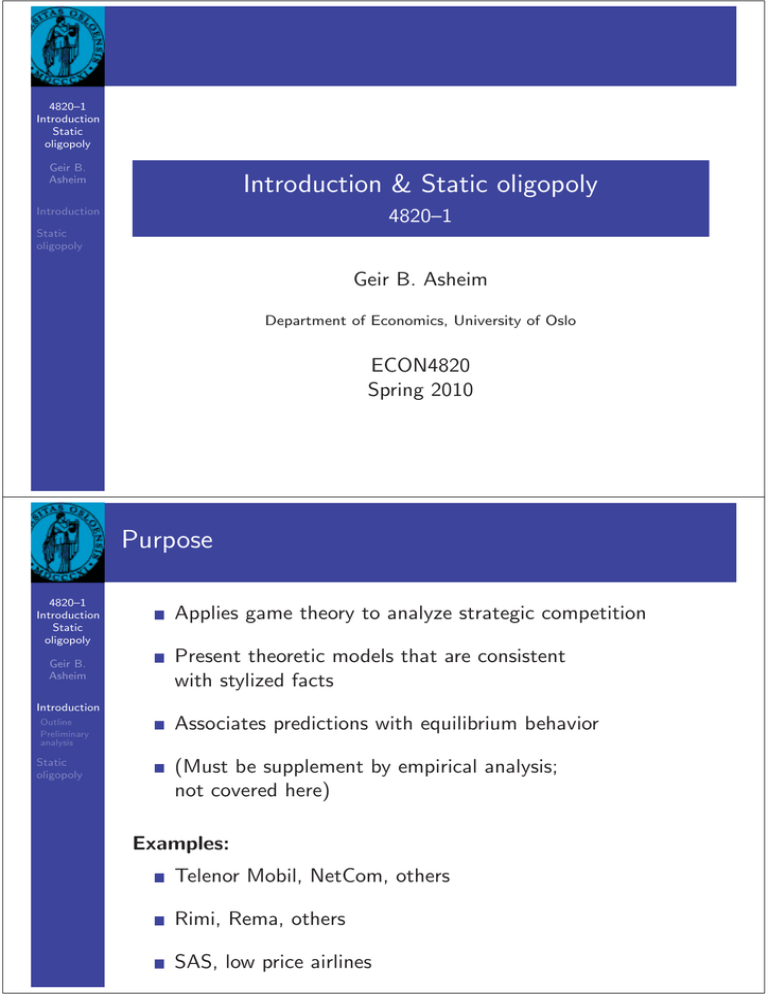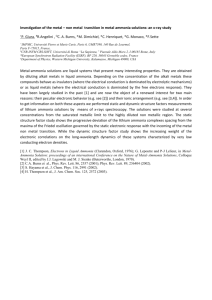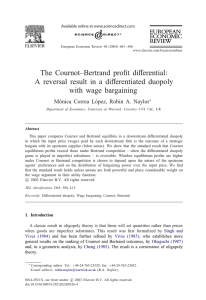Introduction & Static oligopoly Purpose
advertisement

4820–1
Introduction
Static
oligopoly
Geir B.
Asheim
Introduction & Static oligopoly
Introduction
4820–1
Static
oligopoly
Geir B. Asheim
Department of Economics, University of Oslo
ECON4820
Spring 2010
Purpose
4820–1
Introduction
Static
oligopoly
Geir B.
Asheim
Applies game theory to analyze strategic competition
Present theoretic models that are consistent
with stylized facts
Introduction
Outline
Preliminary
analysis
Static
oligopoly
Associates predictions with equilibrium behavior
(Must be supplement by empirical analysis;
not covered here)
Examples:
Telenor Mobil, NetCom, others
Rimi, Rema, others
SAS, low price airlines
What is strategic competition?
4820–1
Introduction
Static
oligopoly
Geir B.
Asheim
Introduction
Outline
Preliminary
analysis
Static
oligopoly
American term: Industrial organization. The study of
activities within an industry, mainly with respect to
competition among the firms in a product market.
Few firms, seeking to avoid or soften competition
Why? The model of perfect competition is unrealistic,
because in many industries, large profits, with p > MC
Who set the prices? The firms
Can they influence prices? Yes, if they are few
But: difficult to find a general model of imperfect
competition
Many models with varying applications
So what does it then mean to explain stylized facts?
Characteristica
4820–1
Introduction
Static
oligopoly
Geir B.
Asheim
Introduction
Outline
Preliminary
analysis
Static
oligopoly
Competition in price or quantities
Static oligopoly (4820–1)
One-time competition or long-term relationship
Dynamic oligopoly (4820–2&3)
Homogeneous or differentiated products
Product differentiation (4820–4&5)
Competition from potential entrants
Entry (4820–6&7)
Symmetric or asymmetric information
Information (4820–8&9)
Other topics:
Research & development
(4820–10)
Auctions
(4820–11)
Vertical integration
(4820–12)
Mergers
(4820–13)
Noncooperative games and strategic behavior
4820–1
Introduction
Static
oligopoly
Geir B.
Asheim
Assume that the profit of firm i (i = 1, 2) depends its own
action ai and the action aj of the other firm j:
Πi (ai , aj )
Introduction
Outline
Preliminary
analysis
Static
oligopoly
The pair (a1∗ , a2∗ ) is a Nash equilibrium if, for each i (i = 1, 2),
Πi (ai∗ , aj∗ ) ≥ Πi (ai , aj∗ )
for all ai
One interpretation: If the firms agrees on (a1∗ , a2∗ ), then the
agreement is self-enforcing in the sense that each firm has not an
incentive to deviate from the agreement, provided that it
believes that the other firm will stick to its part.
Best response functions:
Strategic complements and substitutes
4820–1
Introduction
Static
oligopoly
Geir B.
Asheim
Introduction
Outline
Preliminary
analysis
Static
oligopoly
First-order condition for a Nash equilibrium: For each firm i,
Πii (ai∗ , aj∗ ) = 0
Second-order condition: For each firm i,
Πiii (ai∗ , aj∗ ) ≤ 0
If Πiii (ai , aj ) < 0 for all (ai , aj ), then i’s best response function
Ri (aj ) can be defined by Πii (Ri (aj ), aj ) = 0.
Ri (aj )
=
Πiij (Ri (aj ), aj )
−Πiii (Ri (aj ), aj )
Strategic complements if Ri (aj ) > 0.
Strategic substitutes if Ri (aj ) < 0.
Static oligopoly
4820–1
Introduction
Static
oligopoly
Geir B.
Asheim
Introduction
Price competition: Bertrand model
Static
oligopoly
Bertrand
model
Cournot
model
Price or
quantity
Quantity competition: Cournot model
Price or quantity as strategic variable?
Bertrand model with homogeneous products
4820–1
Introduction
Static
oligopoly
Geir B.
Asheim
Introduction
Static
oligopoly
Bertrand
model
Cournot
model
Price or
quantity
Structure: (1) Prices set (2) Demand determines quantities
D(·): continuous and strictly decreasing demand function for all
p with D(p) > 0; D(p) = 0 for p ≥ p̄. Firms 1 and 2 have
constant unit cost c and set prices p1 and p2 simultaneously.
Sales are given by:
⎧
⎪
if pi < pj
⎨ D(pi )
1
Di (pi , pj ) =
D(pi ) if pi = pj
2
⎪
⎩
0
if pi > pj
Profit is given by: Πi (pi , pj ) = (pi − c)Di (pi , pj ).
Write Πm = maxp (p − c)D(p) and p m = arg maxp (p − c)D(p).
We have that 0 ≤ Π1 + Π2 ≤ Πm . Why?
Unique Nash equilibrium: p1 = p2 = c.
Bertrand paradox
Relaxing competition
4820–1
Introduction
Static
oligopoly
Geir B.
Asheim
Introduction
Static
oligopoly
Bertrand
model
Cournot
model
Price or
quantity
Firms set prices.
But the conclusion of the Bertrand model — that two firms are
sufficient for perfectly competitive outcomes — is unrealistic.
Competition can be relaxed by
Not no capacity contraints, but
capacity constraints (Bertrand oligopoly model
with capacity constraints; Cournot oligopoly model)
Not homogeneous products, but
product differentiation (Bertrand oligopoly model
with heterogeneous products; other models)
Not a static game, but
repeated long-term interaction
Cournot model (1)
4820–1
Introduction
Static
oligopoly
Geir B.
Asheim
Structure: (1) Quantities set (2) Demand determines price
Assume firms first choose quantities q1 and q2 and that these are
sold at price P(q1 + q2 ) in the market, where P(·) is determined
by P(D(p)) = p, with P(0) = p̄. Each firm i’s profit:
Introduction
Static
oligopoly
Bertrand
model
Cournot
model
Price or
quantity
Πi (qi , qj ) = P(qi + qj )qi − C (qi )
max P(qi + qj )qi − C (qi )
qi
First-order condition:
Πii = P(qi + qj ) − C (qi ) + P (qi + qj )qi = 0
For each qj , let Ri (qj ) denote i’s best response:
Πii (Ri (qj ), qj ) = 0
Cournot model (2)
4820–1
Introduction
Static
oligopoly
Geir B.
Asheim
Introduction
Static
oligopoly
Bertrand
model
Cournot
model
Price or
quantity
Nash equilibrium (q1∗ , q2∗ ) satisfies, for each firm i:
qi∗ = Ri (q2∗ ) or, equivalently,
P(qi∗ + qj∗ ) − C (qi∗ ) + P (qi∗ + qj∗ )qi∗ = 0
This can be rewritten as
Li =
αi
,
i
is the Lerner index for firm i, αi ≡ qQi is firm i’s
where Li ≡ P−C
P
market share, and ≡ − PP Q is the elasticity of demand.
Consider a special case: D(p) = 1 − p and Ci (qi ) = ci qi .
Consider the generalization to the case of n firms. Whereas
the Cournot model with n = 1 corresponds to monopoly, the
Cournot model approaches perfect competition as n → ∞.
Concentration indices
4820–1
Introduction
Static
oligopoly
Geir B.
Asheim
Introduction
Static
oligopoly
Bertrand
model
Cournot
model
Price or
quantity
the m-firm concentration ratio (for m < n), which adds up
the m highest shares in the industry:
m
Rm ≡
αi
i=1
(ordering the firms so that α1 ≥ · · · ≥ αm ≥ · · · ≥ αn )
the Herfindahl index, which is equal to the sum of the
squares of the market shares:
m
αi2
RH ≡
i=1
the entropy index, which is equal to the sum of the shares
times their logarithms:
m
Re ≡
αi ln αi
i=1
Total profits under Cournot competition
4820–1
Introduction
Static
oligopoly
Geir B.
Asheim
Introduction
Static
oligopoly
Bertrand
model
Cournot
model
Price or
quantity
Assume that each firm i has constant unit costs ci .
n
n
Π=
Πi =
(p − ci )qi
i=1
i=1
n
n
=
pLi αi Q =
p αi αi Q
i=1
i=1
n
α2 = pQ
= pQ
RH
i=1
If = 1 so that pQ = k, then
Π = kRH
implying that the Herfindahl index yields an exact measure of
industry profitability under these assumptions.
Is price or quantity the strategic variable?
4820–1
Introduction
Static
oligopoly
Geir B.
Asheim
We have seen that price competition yields different predictions
than quantity competition.
Introduction
Static
oligopoly
Bertrand
model
Cournot
model
Price or
quantity
So which model is “right”?
To analyze this, consider a setting where quantities/capacities
are determined before price.
Capacity constrained price competition requires that we specify
rationing rules.
Rationing rules
4820–1
Introduction
Static
oligopoly
Geir B.
Asheim
Introduction
Static
oligopoly
Bertrand
model
Cournot
model
Price or
quantity
Assume that firm 1 has capacity constraint q̄1 , and that firm 1
sets a lower price (p1 < p2 ). What is the demand facing firm 2?
The efficient-rationing rule: A consumer with the highest
willingness-to-pay is served first.
D(p2 ) − q̄1 if D(p2 ) > q̄1
D̃2 (p2 ) =
0
otherwise .
The proportional-rationing rule: Any consumer willing to pay
a good offered at p has an equal change of buying at p.
D(p1 ) − q̄1
.
D̃2 (p2 ) = D(p2 )
D(p1 )
Why is efficient rationing efficient?
More on efficient rationing
4820–1
Introduction
Static
oligopoly
Geir B.
Asheim
Let the firms have capacity constraints q̄1 and q̄2 ,
and assume no cost of production up to these constraints.
If p1 > p2 , then
q2 = min{q̄2 , D(p2 )}
Introduction
Static
oligopoly
Bertrand
model
Cournot
model
Price or
quantity
If p1 < p2 , then
q2 = min{q̄2 , max{0, D(p2 ) − q̄1 }}
If p1 = p2 , then
2)
q̄2 , D(p
2
D(p2 )
2
+ max 0,
− q̄1
D(p2 )
= min q̄2 , max
2 , D(p2 ) − q̄1
q2 = min
Price competition with capacity constraints
The Bertrand-Edgeworth model
4820–1
Introduction
Static
oligopoly
Geir B.
Asheim
Introduction
Static
oligopoly
Bertrand
model
Cournot
model
Price or
quantity
Let R10 (q2 ) and R20 (q1 ) be the firms’ Cournot best response
functions when costs are zero. Assume efficient rationing.
Case 1: Small capacity (q̄1 ≤ R10 (q̄2 ) and q̄2 ≤ R10 (q̄1 ))
Larger profit by producing less that q¯1 ? No!
Nash equilibrium: p1 = p2 = P(q̄1 + q̄2 )
Case 2: Intermediate capacity
((q̄1 > R10 (q̄2 ) or q̄2 > R10 (q̄1 )) & (q̄1 < D(0) or q̄2 < D(0)))
Complicated; Nash equilibria involve mixed strategies.
Case 3: Large capacity (q̄1 ≥ D(0) and q̄2 ≥ D(0))
Like ordinary Bertrand model with zero costs: p1 = p2 = 0.
Capacity competition followed by price competition
4820–1
Introduction
Static
oligopoly
Geir B.
Asheim
Introduction
Static
oligopoly
Bertrand
model
Cournot
model
Price or
quantity
Structure: (1) Capacities set
(2) Prices set
(3) Demand determines quantities
In the subgames starting at stage (3), all possible profiles of
capacities and prices must be considered.
Use the concept of subgame-perfect equilibrium.
Assume efficient rationing. For “small” capacities, prices are
determined as in the Cournot model. Hence, if the cost of
capacities leads to “small” capacities, then capacities will be
determined as in the Cournot model.
Kreps & Scheinkman (1983) show formally
that firms will choose “small” capacities (by showing that at
least one firm has a profitable deviation if one firm does not
choose a “small” capacity): With efficient rationing,
the game considered here leads to the Cournot outcome.
So what is the strategic variable?
4820–1
Introduction
Static
oligopoly
Geir B.
Asheim
Introduction
Static
oligopoly
Bertrand
model
Cournot
model
Price or
quantity
Principle: The least flexible variable is the strategic variable
Usually, capacities are determined before production,
which in turn is determined before price.
Exceptions?




